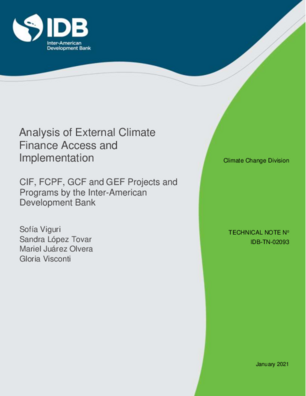Analysis of External Climate Finance Access and Implementation: CIF, FCPF, GCF and GEF Projects and Programs by the Inter-American Development Bank
Date
Jan 2021
In response to the Paris Agreement and the Sustainable Development Goals (SDGs), the IDB Group Board of Governors endorsed the target of increasing climate-related financing in Latin America and the Caribbean (LAC) from 15% in 2015 to 30% of the IDB Groups combined total approvals by 2020. Currently, the IDB Group is on track to meet this commitment, as in 2018, it financed nearly US$5 billion in climate-change-related activities benefiting LAC, which accounted for 27% of total IDB Groups annual approvals. In 2019, the overall volume and proportion of climate finance in new IDBG approvals have increased to 29%.
As the IDB continues to strive towards this goal by using its funds to ramp-up climate action, it also acknowledges that tackling climate change is an objective shared with the rest of the international community. For the past ten years, strategic partnerships have been forged with external sources of finance that are also looking to invest in low-carbon and climate-resilient development. Doing this has contributed to the Banks objective of mobilizing additional resources for climate action while also strengthening its position as a leading partner to accelerate climate innovation in many fields. From climate-smart technologies and resilient infrastructure to institutional reform and financial mechanisms, IDB's use of external sources of finance is helping countries in LAC advance toward meeting their international climate change commitments.
This report collects a series of insights and lessons learned by the IDB in the preparation and implementation of projects with climate finance from four external sources: the Climate Investment Funds (CIF), the Forest Carbon Partnership Facility (FCPF), the Green Climate Fund (GCF) and the Global Environment Facility (GEF). It includes a systematic revision of their design and their progress on delivery, an assessment of broader impacts (scale-up, replication, and contributions to transformational change/paradigm shift), and a set of recommendations to optimize the access and use of these funds in future rounds of climate investment.
The insights and lessons learned collected in this publication can inform the design of short and medium-term actions that support “green recovery” through the mobilization of investments that promote decarbonization.
As the IDB continues to strive towards this goal by using its funds to ramp-up climate action, it also acknowledges that tackling climate change is an objective shared with the rest of the international community. For the past ten years, strategic partnerships have been forged with external sources of finance that are also looking to invest in low-carbon and climate-resilient development. Doing this has contributed to the Banks objective of mobilizing additional resources for climate action while also strengthening its position as a leading partner to accelerate climate innovation in many fields. From climate-smart technologies and resilient infrastructure to institutional reform and financial mechanisms, IDB's use of external sources of finance is helping countries in LAC advance toward meeting their international climate change commitments.
This report collects a series of insights and lessons learned by the IDB in the preparation and implementation of projects with climate finance from four external sources: the Climate Investment Funds (CIF), the Forest Carbon Partnership Facility (FCPF), the Green Climate Fund (GCF) and the Global Environment Facility (GEF). It includes a systematic revision of their design and their progress on delivery, an assessment of broader impacts (scale-up, replication, and contributions to transformational change/paradigm shift), and a set of recommendations to optimize the access and use of these funds in future rounds of climate investment.
The insights and lessons learned collected in this publication can inform the design of short and medium-term actions that support “green recovery” through the mobilization of investments that promote decarbonization.




